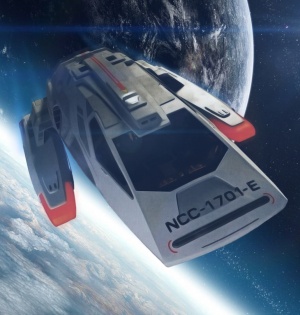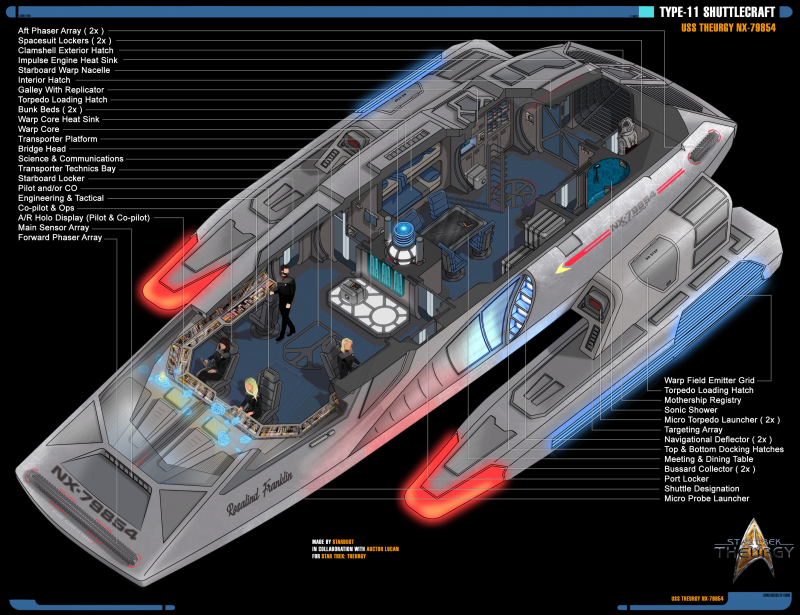Type-11 Shuttlecraft
From Star Trek: Theurgy Wiki
 Design © Paramount and CBS / Image by Stardust
| ||
| Name: | Type-11 Shuttlecraft | |
| Ship Type: | Auxiliary Support Craft | |
| Production Status: | Ongoing | |
| Role: |
| |
| Constructed: | 2372-present | |
| Dimensions: |
| |
| Mass: | 27,200 kg | |
| Standard Crew Complement: |
| |
| Warp Speeds: | ||
| Tactical Specs: |
| |
| Defensive Specs: |
| |
| Other Systems |
| |
| Other Standard-issue Equipment |
|
|
The Type-11 shuttlecraft was a large auxiliary craft issued to certain Starfleet ships and starbases throughout the 2370s. By 2381, the Type-11 shuttlecraft had become ubiquitous throughout the Federation as one of the largest and most capable auxiliary craft in any starship's inventory, with several Type-11's being delivered to the USS Theurgy.
Production History
In the late 2360s, the introduction of the new Galaxy-class starships brought with them new lessons for Starfleet. In particular, classic shuttlecraft designs were deemed to be insufficient for Starfleet's expanding needs as auxiliary craft were relied on more and more by starship crews. Creative starship crews began to use the plentiful shuttlecraft aboard the new Galaxy-class for missions beyond their design parameters, supplementing exploration of large areas and deploying them for short-term science missions, prompting Starfleet to respond. The Type-9 shuttlecraft, while promising, was far too small to accommodate crew comfort for multi-day missions, and increasing loss rates were beginning to alarm Starfleet Command about the design's reliability. The Danube-class runabout, while sufficiently capable to meet the mission requirements, was deemed far too large and expensive to be deployed to the fleet in general.
As a result, the Type-11 project was launched in 2369 in the hopes of the type being ready for the new Sovereign-class starships then under construction. The mandate was simple enough: build an intermediate design between the Type-9 shuttle and the Danube-class runabout, with modularity for ease of maintenance. The design needed sleeping accommodation for multi-day missions and the same warp performance as a runabout, although Starfleet compromised on flight endurance and tactical capability to make the project viable. At the same time, the Type-11 was mandated to be of flatter, more streamlined design than the Danube-class inspiration to accommodate most standard shuttle bays more easily.
Using technology developed for the Sovereign-class starships, the first line of Type-11 shuttles were built in 2372, first deployed to the USS Sovereign, USS Enterprise-E and USS Poseidon. The shuttles proved an immediate success, leading to the widespread adoption of the craft throughout the Federation, finding a place on most large starships and starbases. Serving effectively during the Dominion War and beyond, the Type-11 would become the standard large shuttlecraft for Starfleet for many years to come.
Propulsion Systems
The micro-warp core in the Type-11, despite being considerably smaller and less powerful than the warp core of the Danube-class runabout, provided similar performance. Due to it's vertical layout, with minimised versions of technological advances implemented on the Sovereign class, the core was of a much simpler and cheaper design than the horizontal configuration on the runabout. At a cruising speed of warp 4, the Type-11 could cover considerable distance within only a few days, facilitating precisely the sort of missions envisaged for the Type-11. Moreover, the warp core was modular and easily accessed from the transporter pad, to ensure ease of maintenance for a starship crew with limited resources and manpower. Additionally the center position within the spaceframe provided the most structural protection possible, another lesson learned from the runabout warp-core, which ran exposed along its spine and had proved vulnerable in service.
As an unexpected benefit of the warp core design, the Type-11’s warp drive could be modified and enhanced with relative ease by an inventive individual, even in mid-flight. Given the increased risk of a warp core breach as a result, however, the Corps of Engineers officially declared that such modifications were “not advised”.
At sublight the Type-11 performed much as expected for its size, being far clumsier than the smaller Type-9, but far more maneuverable than actual starships or even runabouts. Sporting excessively large heatsinks for its size at the back of the craft, the Type-11 did, however, have a far lower detection threshold when flying on impulse engines than comparably sized craft. Due to its innovative lightweight design, it also had a 15% better acceleration rate than the Danube class.
Due to its mission parameters the Type-11 design was also capable of atmospheric flight. Due to its aerodynamic design it would fare much better in dense mediums than most previous shuttlecraft. Building on that design, Starfleet Engineering even produced updated versions that were specifically designed to operate even deep underwater, albeit in significantly lower quantities, as these were highly specialised craft.
Tactical Systems
While reasonably well armed for a shuttle, the Type-11 was not designed for any sort of serious combat. Equipped with four Type-IV phaser arrays to ensure omnidirectional fire, the shuttle’s weapons were intended more as weapons of opportunity than practicality. The true teeth of the craft came from its micro photon torpedoes, a design feature copied from the Danube-class. Providing a measure of offensive firepower against more heavily defended targets, the micro-torpedo launchers also fired configurable micro-probes, permitting increased versatility.
There were, however, some safety concerns that arose after years of service over the storage of the micro-photon-torpedoes in the pylons of the warp nacelles. The design intent had been to facilitate faster reload speeds and added security for the pressurised cabin, as well as easier resupply through an external hatch. However, keeping antimatter warheads near the nacelles proved a serious vulnerability due to the risk of the micro-torpedoes detonating accidentally due to damage, with a single well-aimed phaser or disruptor blast being capable of crippling or destroying the shuttle. The vulnerability would become one of the most heavily debated drawbacks of the Type-11 design.
Due to its size, design and innovative warp core, the Type-11 had impressive shield systems, nearly three times more resilient than the smaller Type-9.
Crew Support Systems
In keeping with its design mandate, the type-11 incorporated a separate aft compartment that included a small galley, a replicator, two bunks, a waste disposal port, a sonic shower and numerous storage closets in its base configuration. Due to its modular interior makeup, however, the aft compartment could see its four basic components replaced on a moment's notice. This allowed the shuttle to facilitate up to 8 bunks as a personnel transport, 4 bunks with a galley and shower facility for long-term missions, or even an extended cargo area, if all four module-slots were left vacant.
The back airlock and clamshell exterior doors were specifically designed to the exact dimensions of the interior modules and Type-7 cargo containers, to facilitate easy and effortless loading and refurbishing. For the cargo configuration the conference table, chairs and airlock ladder could be removed.


